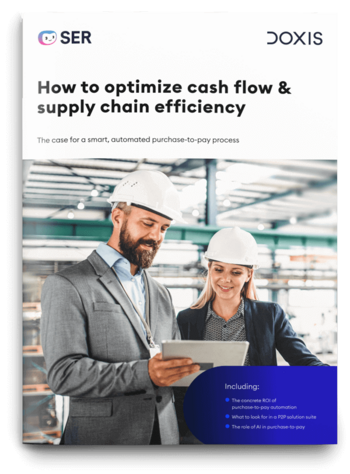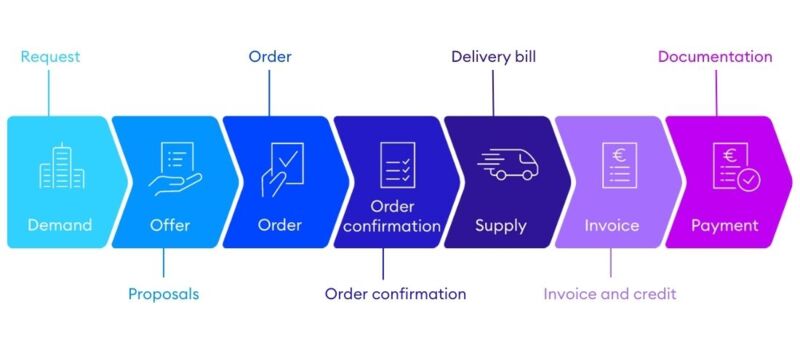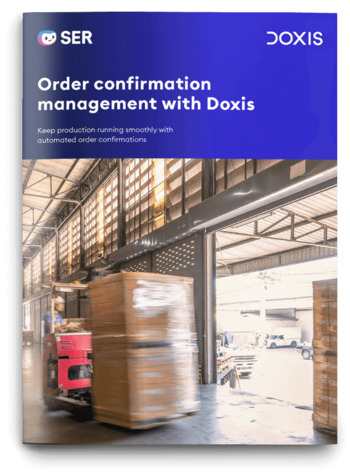SER Blog Customer Stories & Use Cases
Key steps in the procurement process
How you can optimize the process
In many companies, the procurement process is complex and consists of many small steps. With the right strategies and tools, you can get full control over all the steps, accelerate goods procurement, and reduce your costs. Learn exactly how this works in the following article.
First, let’s look closely at the steps that make up the procurement process.

Definition: brief explanation of the procurement process
The procurement process, or procure-to-pay process, describes all processes that deal with strategic planning and the purchase of goods. The goal is to provide the company with all the goods and services it needs in the long and short terms, while making this process as efficient and cost-effective as possible.
In short, an optimal procurement process ensures that the right goods (the procurement object) are in the right place at the right time – in the right quantity, the right quality, and at the right price.
Types of procurement processes
There are different forms of procurement processes that you can use depending on the requirement and procurement object. Here is an overview of the three most important procurement processes:
- Individual procurement: With individual procurement, you purchase the goods individually, e.g. whenever there is a special customer order for them.
- Stock procurement: Stock procurement aims to create a large quantity of goods and materials in stock in order to continuously serve orders.
- Just-in-time procurement: The goal of just-in-time procurement is to always deliver the required goods right when they are needed.

The case for a smart, automated purchase-to-pay process
Optimize cash flow & supply chain efficiency in purchase-to-pay processes – this white paper shows you how. ⯈
Read nowDifference between purchasing and procurement
The terms purchasing and procurement are often used as synonyms, but they refer to different stages and focus areas in the procurement process. Purchasing is the operational part of a strategically-aligned procurement process. We also distinguish between operational and strategic procurement processes.
Strategic procurement
Strategic procurement deals with long-term procurement planning and optimization of the procurement process. It is an enterprise-wide process that is aligned with business objectives and relies primarily on data and analysis.
The strategic part of the procurement process deals, for example, with the question of which goods are needed at all, which goods cover the requirement, which suppliers* are suitable, and which price is the best.
This is also known as an upstream procurement process: This includes all the stages and decisions that are made up until the actual order.
Note: An important part of strategic procurement is the selection and management of suppliers and the optimization of supplier relationships. You can read more about this topic in our blog post on supplier management.
Operational procurement
Operational procurement describes the actual order process (purchase-to-pay). This is mainly the responsibility of purchasing and consists primarily of transactional tasks that are repeated. In short, this process covers the normal day-to-day business of purchasing goods.
Individual stages of the procurement process
We go into more detail about the five most important stages of the procurement process below. In practice, the procurement process can be broken down into even more small steps – and the process varies from company to company.
1. Requirements planning
Every procurement process begins with the purchase requisition. This means that you identify a requirement in your company and instruct the purchasing department to meet the requirement by procuring the necessary goods.
The purchase requisition usually includes the following steps:
Requirements planning
At the outset, there is the following question: What is the actual requirement? As mentioned above, a requirement arises, for example, when a specific order is received or when the stock needs to be replenished.
There are basically three types of requirements:
- Primary requirements: This means all salable goods and products (end products) that you sell to your customers.
- Secondary requirements: The secondary requirements include all the materials, raw materials, individual parts, or assemblies that you need to manufacture the sales product.
- Tertiary requirements: Tertiary requirements include, among other things, auxiliary and operating materials, as well as tools subject to wear and tear that are required for production but do not flow directly into the end product.
Inventory control is also part of requirements planning. By constantly checking the target value and the actual stock, you get important information about your requirements, for example, about the average consumption or the required minimum stock.
Procurement request
Once you have identified a requirement, submit a procurement request to the Purchasing department. Your company usually has the appropriate forms for this, where you provide all the necessary information, including the type of procurement item, the quantity, or the reason for the requirement. Purchasing then reviews the request.
Approval
If the Purchasing department has no objections to the planned purchase order, the purchase order is approved. In addition, of course, the budget must also be approved, which is usually the responsibility of Controlling.
Issue purchase order
Once approved, the purchase order can be issued and the order can be launched. We’ll look closer at this step in Stage 3.
2. Supplier selection and quotes
A crucial aspect of procurement is who you actually procure the required goods and services from. The selection of suitable suppliers should ideally take place before the actual procurement process as part of strategic supplier management.
You can then obtain non-binding quotes from the selected suppliers – either as a general request or for your specific requirements. By comparing the quotes, for example, in terms of quality, delivery times, price and payment terms, you can then select the best quote.
The next step is to carry out contract negotiations before you conclude a purchase contract or a contract for work and services.
3. Purchase orders and order confirmations
Once you have found a suitable quote, issue the purchase order. As soon as you receive the order confirmation, be sure to review it closely and check it against the PO data. It is also important to monitor the order and document the order history. For example, make sure that the right items are actually delivered in the right quantity and that the agreed delivery times are met.
4. Incoming goods
When the ordered goods arrive, this must always be documented and the delivery must be checked carefully. The most important questions for this step are:
- Does the delivery correspond to the order?
- Does the delivery match the information on the delivery note?
- Was there any damage during shipping?
- Is the quality of the products acceptable or are there defects?
The delivery must then be recorded by the Accounting department and, last but not least, forwarded to the right recipient, for example, to production.
5. Payments processing
Next up – the payments step. Depending on what you agreed in the contract, an advance payment or down payment was due prior to delivery, or you agreed on payment at a certain time, or payments are due in installments.
In any case, the accounting department has to record and review the invoice before posting it and issuing payment authorization. With payment, the procurement process is officially concluded.
Next steps
We would like to discuss two other aspects that are still relevant to the procurement process after the payment process.
Supplier assessment
For transparent supplier management and to continuously optimize the procurement process, you should ideally evaluate supplier performance every time. Important criteria are, for example, product quality, compliance with schedules, price development, communication, service, and the innovativeness of the supplier.
Archiving
Another step that should not be neglected is archiving. All documents generated in the procurement process must be archived in an audit-proof manner and stored in accordance with statutory retention periods.
Optimizing procurement processes with eProcurement

As we have seen, the procurement process consists of many small steps. There are a number of internal approval and release processes with different stakeholders, and a number of documents are generated, including:
- Procurement requests
- Quotes from suppliers
- Orders
- Order confirmations
- Delivery notes
- Invoices
In order to keep an overview and to make the processes as efficient as possible, you should digitize and automate your procurement process. Electronic procurement (eProcurement) can have many benefits for you: You create enterprise-wide standardized workflows, accelerate routine work activities, promote interactive collaboration and teamwork, and prevent media disruptions.
What matters to manufacturing leaders today
Our international survey revealed:
- The 5 biggest challenges in the industry
- The 6 most important trends you should't miss
- The 3 most promising digital transformation projects in 2024

Use Case: Order confirmations with Doxis + SAP
Large industrial companies receive an average of 4,000 or more order confirmations by email every month. The responsible employees have to check these as soon as possible after receipt and compare them with the SAP order.
The problem: Not every order confirmation looks the same and it takes time for employees to manually enter and check the most important information, such as order number, delivery date, payment terms, quantities and prices. If there are any discrepancies, the employees have to clarify this with everyone involved, which is a time-consuming activity.
The solution: With Doxis, our enterprise content management solution with an interface to SAP, processing order confirmations is much easier and faster:
- The AI-supported solution suite Doxis Intelligent Order Confirmation Automation gives you a transparent overview of all your order confirmations. You can see at a glance the status, which employee is currently responsible for processing, and whether there are any deviations from the order.
- Doxis automatically adopts the data from the order confirmation and uses it to trigger the right workflows. When you open the order confirmation in the system, your current task is displayed directly, for example, that you have to validate the data.
- With direct document view, you can easily review the acquired data side-by-side.
- In addition, the software compares the data in the order confirmation with the order data from your ERP system and shows you the discrepancies. You can determine in advance which deviations are critical for your company and which are acceptable.
- With the click of a button, you release the order confirmation after review, post it, reject it, or raise queries. You can also add personalized notes.
- After processing, the order confirmation is stored in an audit-proof manner in the Doxis archive.
- All the information is synchronized with SAP via the interface, so that you can access all documents and attached workflows directly from there.
The major benefit: Thanks to AI support, you need much less time for the order confirmation. Order confirmations where no discrepancies are found can be automated fully. This results in significant cost savings and accelerates the general procurement process – which benefits your production process and your time-to-market.

Automating the order confirmation process – learn how
Find out how you can digitize your order confirmations with Doxis and reconcile them with your SAP orders.
Read the brochure nowFrequently asked questions about the procurement process
The most important steps in the procurement process include the purchase requisition and approval, the selection of suppliers and gathering of quotes, the ordering process, the inspection of incoming goods, and finally payment processing.
The procurement process describes all the steps that are necessary to provide a company with the goods and services it needs. It includes both strategic and operational activities for purchasing goods.
Procurement is a long-term, strategic plan to optimize procurement. Purchasing, on the other hand, refers to the operational part of the procurement process and deals with the day-to-day activities related to the ordering process.
The latest digitization trends, laws and guidelines, and helpful tips straight to your inbox: Subscribe to our newsletter.
How can we help you?
+49 (0) 30 498582-0Your message has reached us!
We appreciate your interest and will get back to you shortly.




